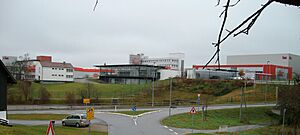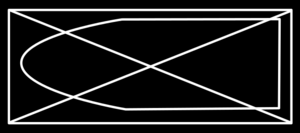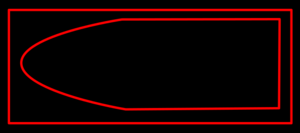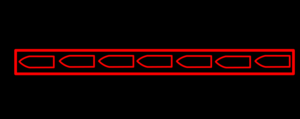- This page was last modified on 17 October 2025, at 10:18. Suggest an edit.
Heckler & Koch facts for kids
 |
|
| Private (GmbH) | |
| Industry | Defense |
| Founded | 28 December 1949 |
| Founders |
|
| Headquarters |
Oberndorf am Neckar
,
Germany
|
|
Area served
|
Worldwide |
|
Key people
|
Jens Bodo Koch (CEO) |
| Products | Firearms, weapons |
| Revenue | |
|
Operating income
|
|
| Total assets | |
| Total equity | |
|
Number of employees
|
1,156 (2023) |
Heckler & Koch GmbH, often called HK or H&K, is a German company that makes different types of firearms. These include handguns, rifles, submachine guns, and grenade launchers. The company is based in Oberndorf am Neckar, Germany. It also has offices in the United Kingdom, France, and the United States.
Heckler & Koch was started in 1949 by three engineers: Edmund Heckler, Theodor Koch, and Alex Seidel. They used parts of an old factory to begin their new company. At first, they made tools and metal parts. In 1956, they created their first firearm, the G3 rifle. This rifle was a big success and helped HK become a major defense company. Their company motto is "Keine Kompromisse!" which means "No Compromises!"
Since July 2020, a company called CDE, owned by Nicolas Walewski, has been the main owner of Heckler & Koch.
Contents
How Heckler & Koch Started
After World War II, the town of Oberndorf was controlled by France. The old Mauser factory there was taken apart. In 1948, three engineers from Mauser saved what they could from the factory. These engineers were Edmund Heckler, Theodor Koch, and Alex Seidel. They used the salvaged parts to start a new company. It was first called the Engineering Office Heckler & Co.
On December 28, 1949, the company officially became Heckler & Koch GmbH. They started by making machine tools, parts for bicycles and sewing machines, and other precise metal parts.
In 1956, the West German government needed a new rifle for its army, the Bundeswehr. Heckler & Koch offered their G3 rifle. This rifle was based on a Spanish design called the CETME Model 58. The German government chose the G3, and in 1959, it became the standard rifle for the Bundeswehr. In 1961, HK also developed the HK21 machine gun, which was also based on the G3.
In 1966, Heckler & Koch introduced the HK54. This weapon later became known as the MP5 submachine gun in 1969. Two years later, they released the HK33 assault rifle. This was a smaller version of the G3.
Growing the Company
In 1974, Heckler & Koch expanded into two main areas. One was for defense and law enforcement technology. The other was for hunting and sports firearms. Since then, HK has designed over 100 different types of firearms. These are used by armies, police forces, and sports shooters around the world.
In 1990, HK worked on a new type of weapon system that didn't use bullet casings. They made prototypes of the G11 rifle. They also made prototypes of the G41 assault rifle for the German army. However, due to changes in politics and defense spending, HK could not get contracts to produce these weapons. This made the company financially weak. In 1991, Heckler & Koch was sold to a British company called Royal Ordnance.
Between 1994 and 1995, the German government gave Heckler & Koch contracts for new standard weapons. HK developed the G36 assault rifle, which was made with lightweight carbon fiber. They also produced the P8 pistol, based on their USP handguns. The USP became the standard pistol for the German army in 1994, and the G36 became their standard rifle in 1995.
In 1999, Royal Ordnance, which owned HK, merged with another company. This meant Heckler & Koch became part of BAE Systems. HK was then hired to fix problems with the British Army's SA80 rifles. In 2002, BAE Systems sold Heckler & Koch to a group of private investors.
In 2003, Heckler & Koch reorganized its business. It again separated into two main areas: Defense and Law Enforcement, and Sporting Firearms. In 2004, HK won a large contract to provide handguns to the United States Department of Homeland Security. This was one of the biggest handgun contracts in U.S. law enforcement history.
The United States Army also hired HK to work on a new weapon called the Objective Individual Combat Weapon (OICW). This weapon was meant to replace the M16 rifle and M203 grenade launcher. The OICW was designed to fire both 5.56 mm rounds and 25 mm grenades. A part of this weapon was also developed separately as the XM8. However, both the OICW and XM8 projects were stopped.
Heckler & Koch also developed a version of the AR-15/M4 called the HK416. This rifle uses a different system for firing than the original M16. Civilian versions of this rifle are sold as the MR223 and MR556A1.
In 2007, the HK416, along with other rifles, was tested against the M4 carbine in a "dust chamber." The HK416 performed very well, having few failures. In the same year, the Norwegian Army became the first to use the HK416 as its standard rifle.
HK sells its pistols in the United States to police and civilians through its HK USA company. They have locations in Virginia, New Hampshire, and Georgia.
What Heckler & Koch Makes
- Further information: List of Heckler & Koch products
Heckler & Koch has made many different firearms. Some of their most famous ones include the G3, MP5, G36, and HK416. These weapons are used by many armies and police forces worldwide. HK has also created many prototype weapons, like the G11 and XM8.
HK is known for new ideas in firearms. They were among the first to use polymer (a type of plastic) in weapon designs. They also developed modern polygonal rifling for barrels. They explored the idea of high-speed caseless ammunition and created built-in rails for attaching accessories to handguns.
How HK Names Its Products
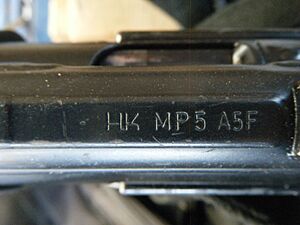
The name of the MP5A5 comes from the HK naming system:
MP (Maschinenpistole - Machine Pistol)
5 (Selective fire carbine)
A5 (Model 5)
MP (Maschinenpistole - Machine Pistol)
5 (Selective fire carbine)
A5 (Model 5)
Heckler & Koch uses a special system to name its products. It usually includes a short abbreviation and a two- or three-digit number. This system helps identify and tell apart different weapons.
However, not all HK products follow this system strictly. Sometimes, names are chosen for marketing reasons. For example, the HK416 doesn't perfectly fit the system. It was originally based on two different models.
Abbreviations in Names
Most HK products have a one to three-letter prefix. These letters usually stand for a German word or term. Some abbreviations are also used at the end of a name to show specific versions of a weapon.
| Letter | German Meaning | English Meaning | Where it's Used | What it Means | Example |
|---|---|---|---|---|---|
| HK | N/A | Heckler & Koch | Prefix | Basic prefix for HK products | HK417, HK45 |
| A | Ausführung | Model, Variant, Version | Suffix | Different versions of existing designs | "G3" is the original G3 rifle. "G3A1" is a version with a retractable stock. |
| G | Gewehr | Rifle | Prefix | Rifles, especially those for military use | G41 |
| K | Kurz | Short | Suffix | Smaller, shortened versions of handguns and submachine guns | MP5K |
| Karabiner | Carbine | Carbine versions of rifles | G36K | ||
| C | N/A | Compact | Suffix | Smaller, shortened versions of rifles | G36C |
| MG | Maschinengewehr | Machine Gun | Prefix | Machine guns | MG4 |
| MP | Maschinenpistole | Machine Pistol, Submachine Gun | Prefix | Submachine guns and personal defense weapons | MP5 |
| PSG | Präzisionsschützengewehr | Precision Sharpshooter Rifle | Prefix | Rifles designed for very accurate shooting | PSG1 |
| SD | Schalldämpfer | Sound Dampener, Suppressor | Suffix | Weapons with a built-in sound suppressor | MP5SD |
| SK | Subkompakt | Subcompact | Suffix | Very small versions of handguns, often for easy carrying | P2000 SK |
| SL | Selbstlader | Autoloader | Prefix | Semi-automatic firearms, usually for hunting or civilian use | SL8 |
| UMP | N/A | Universal Machine Pistol | Prefix | A specific submachine gun | UMP |
| USP | Universale Selbstladepistole | Universal Self-Loading Pistol | Prefix | A specific handgun | USP |
| VP | Volkspistole | People's Pistol | Prefix | Handguns, often with plastic frames, for civilian use | VP70, VP9 |
Number Codes for Products
The number part of the name, called Werknummern, uses two or three digits. These numbers tell you about the weapon's generation, size, and what kind of ammunition it uses.
| First Digit | Second Digit | Third Digit | |||||
|---|---|---|---|---|---|---|---|
| None | 1st Generation | 1 | Magazine-fed machine gun | 1 | 7.62×51mm NATO | ||
| 1 | 2nd Generation | 2 | Belt-fed machine gun | 2 | 7.62×39mm | ||
| 2 | 3rd Generation | 3 | Full-size rifle | 3 | 5.56×45mm NATO | ||
| 3 | 4th Generation | 4 | Semi-automatic military carbine | 4 | 9×19mm Parabellum, .40 S&W, .45 ACP | ||
| 4 | 5th Generation | 5 | Selective fire carbine | 5 | .50 BMG | ||
| 5 | 6th Generation | 6 | Shoulder-fired grenade launcher | 6 | HK 4.6×30mm | ||
| 6 | 7th Generation | 7 | Underbarrel grenade launcher | 7 | .300 AAC Blackout | ||
| 7 | 8th Generation | 8 | Hunting rifles | 8 | 37mm grenade | ||
| 8 | 9th Generation | 9 | N/A | 9 | 40mm grenade | ||
Date Codes
Heckler & Koch handguns have a two-letter code that shows the year they were made. This code is printed on the weapon itself.
| Letter | Number | Examples |
|---|---|---|
| A | 0 | AF – 05 – 2005 |
| B | 1 | |
| C | 2 | |
| D | 3 | BG – 16 – 2016 |
| E | 4 | |
| F | 5 | |
| G | 6 | |
| H | 7 | CE – 24 – 2024 |
| I | 8 | |
| K | 9 | |
| The letter J is not used as a date code. | ||
Handguns made in HK's German factories have "DE" on them. This stands for Germany. Handguns made outside Germany, or before 2008, do not have this "DE" mark.
Trigger Controls
Heckler & Koch rifles and other long weapons often use similar controls for firing and safety. These controls have special markings and pictures.
| Type | Positions | Settings | Location |
|---|---|---|---|
| SEF | 3-position | Safe (Sicher), semi-automatic (Einzelfeuer), full automatic (Feuerstoß) | Left-side |
| 0-1-20 | 3-position | Safe, semi-automatic, full automatic | Left-side |
| SE / 0-1 | 2-position | Safe, semi-automatic | Ambidextrous |
| Navy | 3-position | Safe, semi-automatic, full automatic | Ambidextrous |
| Navy 3-Round Burst | 4-position | Safe, semi-automatic, 3-round burst, full automatic | Ambidextrous |
| Navy 2-Round Burst | 4-position | Safe, semi-automatic, 2-round burst, full automatic | Ambidextrous |
See also
 In Spanish: Heckler & Koch para niños
In Spanish: Heckler & Koch para niños
- List of modern armament manufacturers


